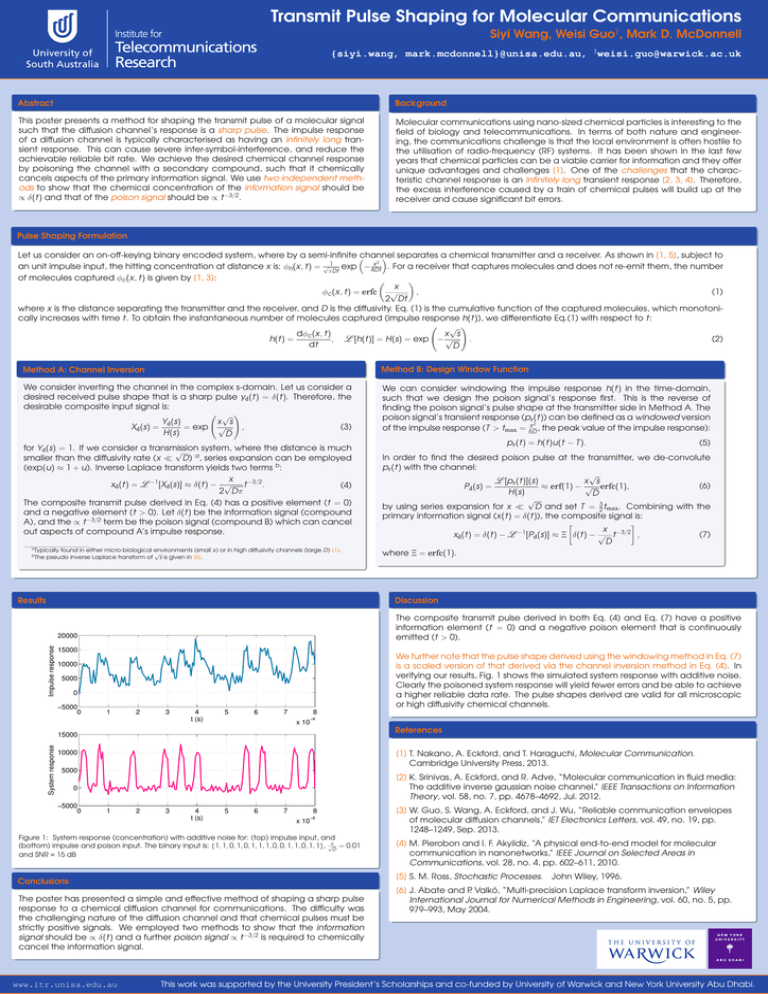Transmit Pulse Shaping for Molecular Communications Siyi Wang, Weisi Guo {siyi.wang, ,
advertisement

Transmit Pulse Shaping for Molecular Communications
Siyi Wang, Weisi Guo†, Mark D. McDonnell
{siyi.wang, mark.mcdonnell}@unisa.edu.au, †weisi.guo@warwick.ac.uk
Abstract
Background
This poster presents a method for shaping the transmit pulse of a molecular signal
such that the diffusion channel’s response is a sharp pulse. The impulse response
of a diffusion channel is typically characterised as having an infinitely long transient response. This can cause severe inter-symbol-interference, and reduce the
achievable reliable bit rate. We achieve the desired chemical channel response
by poisoning the channel with a secondary compound, such that it chemically
cancels aspects of the primary information signal. We use two independent methods to show that the chemical concentration of the information signal should be
∝ δ(t) and that of the poison signal should be ∝ t −3/2.
Molecular communications using nano-sized chemical particles is interesting to the
field of biology and telecommunications. In terms of both nature and engineering, the communications challenge is that the local environment is often hostile to
the utilisation of radio-frequency (RF) systems. It has been shown in the last few
years that chemical particles can be a viable carrier for information and they offer
unique advantages and challenges [1]. One of the challenges that the characteristic channel response is an infinitely long transient response [2, 3, 4]. Therefore,
the excess interference caused by a train of chemical pulses will build up at the
receiver and cause significant bit errors.
Pulse Shaping Formulation
Let us consider an on-off-keying binary encoded system, where by a semi-infinite channel
separates a chemical transmitter and a receiver. As shown in [1, 5], subject to
2
1
x
an unit impulse input, the hitting concentration at distance x is: φh(x, t) = √πDt
exp − 4Dt
. For a receiver that captures molecules and does not re-emit them, the number
of molecules captured φc (x, t) is given by [1, 3]:
x
√
,
(1)
φc (x, t) = erfc
2 Dt
where x is the distance separating the transmitter and the receiver, and D is the diffusivity. Eq. (1) is the cumulative function of the captured molecules, which monotonically increases with time t. To obtain the instantaneous number of molecules captured (impulse response h(t)), we differentiate Eq.(1) with respect to t:
√ !
dφc (x, t)
x s
h(t) =
.
(2)
, L [h(t)] = H(s) = exp − √
dt
D
Method A: Channel Inversion
Method B: Design Window Function
We consider inverting the channel in the complex s-domain. Let us consider a
desired received pulse shape that is a sharp pulse yd(t) = δ(t). Therefore, the
desirable composite input signal is:
√ !
Yd(s)
x s
Xd(s) =
= exp √
,
(3)
H(s)
D
We can consider windowing the impulse response h(t) in the time-domain,
such that we design the poison signal’s response first. This is the reverse of
finding the poison signal’s pulse shape at the transmitter side in Method A. The
poison signal’s transient response (pr(t)) can be defined as a windowed version
x2
of the impulse response (T > tmax = 6D
, the peak value of the impulse response):
for Yd(s) = 1. If we consider a transmission
system, where the distance is much
√
smaller than the diffusivity rate (x D) a, series expansion can be employed
(exp(u) ≈ 1 + u). Inverse Laplace transform yields two terms b:
x
xd(t) = L −1[Xd(s)] ≈ δ(t) − √ t −3/2.
(4)
2 Dπ
The composite transmit pulse derived in Eq. (4) has a positive element (t = 0)
and a negative element (t > 0). Let δ(t) be the information signal (compound
A), and the ∝ t −3/2 term be the poison signal (compound B) which can cancel
out aspects of compound A’s impulse response.
a
b
Typically found in either micro-biological environments
(small x) or in high diffusivity channels (large D) [1].
√
The pseudo inverse Laplace transform of s is given in [6].
Results
pr(t) = h(t)u(t − T ).
(5)
In order to find the desired poison pulse at the transmitter, we de-convolute
pr(t) with the channel:
√
L [pr(t)](s)
x s
(6)
Pd(s) =
≈ erf(1) − √ erfc(1),
H(s)
D
√
by using series expansion for x D and set T = 32 tmax. Combining with the
primary information signal (x(t) = δ(t)), the composite signal is:
x
xd(t) = δ(t) − L −1[Pd(s)] ≈ Ξ δ(t) − √ t −3/2 ,
(7)
D
where Ξ = erfc(1).
Discussion
The composite transmit pulse derived in both Eq. (4) and Eq. (7) have a positive
information element (t = 0) and a negative poison element that is continuously
emitted (t > 0).
Impulse response
20000
15000
We further note that the pulse shape derived using the windowing method in Eq. (7)
is a scaled version of that derived via the channel inversion method in Eq. (4). In
verifying our results, Fig. 1 shows the simulated system response with additive noise.
Clearly the poisoned system response will yield fewer errors and be able to achieve
a higher reliable data rate. The pulse shapes derived are valid for all microscopic
or high diffusivity chemical channels.
10000
5000
0
−5000
0
1
2
3
4
t (s)
5
6
7
8
−4
x 10
References
System response
15000
10000
[1] T. Nakano, A. Eckford, and T. Haraguchi, Molecular Communication.
Cambridge University Press, 2013.
5000
[2] K. Srinivas, A. Eckford, and R. Adve, “Molecular communication in fluid media:
The additive inverse gaussian noise channel,” IEEE Transactions on Information
Theory, vol. 58, no. 7, pp. 4678–4692, Jul. 2012.
0
−5000
0
1
2
3
4
t (s)
5
6
7
8
−4
x 10
Figure 1: System response (concentration) with additive noise for: (top) impulse input, and
(bottom) impulse and poison input. The binary input is: {1, 1, 0, 1, 0, 1, 1, 1, 0, 0, 1, 1, 0, 1, 1}, √xD = 0.01
and SNR = 15 dB
[4] M. Pierobon and I. F. Akyildiz, “A physical end-to-end model for molecular
communication in nanonetworks,” IEEE Journal on Selected Areas in
Communications, vol. 28, no. 4, pp. 602–611, 2010.
[5] S. M. Ross, Stochastic Processes.
Conclusions
The poster has presented a simple and effective method of shaping a sharp pulse
response to a chemical diffusion channel for communications. The difficulty was
the challenging nature of the diffusion channel and that chemical pulses must be
strictly positive signals. We employed two methods to show that the information
signal should be ∝ δ(t) and a further poison signal ∝ t −3/2 is required to chemically
cancel the information signal.
www.itr.unisa.edu.au
[3] W. Guo, S. Wang, A. Eckford, and J. Wu, “Reliable communication envelopes
of molecular diffusion channels,” IET Electronics Letters, vol. 49, no. 19, pp.
1248–1249, Sep. 2013.
John Wiley, 1996.
[6] J. Abate and P. Valkó, “Multi-precision Laplace transform inversion,” Wiley
International Journal for Numerical Methods in Engineering, vol. 60, no. 5, pp.
979–993, May 2004.
This work was supported by the University President’s Scholarships and co-funded by University of Warwick and New York University Abu Dhabi.

![[ ] [ ] ( )](http://s2.studylib.net/store/data/011910597_1-a3eef2b7e8a588bc8a51e394ff0b5e0e-300x300.png)




